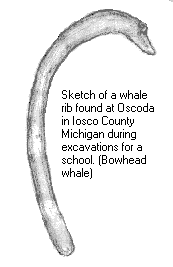Michigan's Fossil WhalesThe discovery of fossil whale bones in Michigan has been a source of some embarrassment for the conventional geologic story of the history of the Great Lakes region, and the notion that the area has remained above sea level for 290 million years since the end of the Pennsylvanian period, as whale fossils are obviously evidence that the land was submerged beneath the sea.
Geologist Alexander Winchell mentioned the discovery of a fossil caudal vertebra from a large whale in a report of the Geologic Survey of Michigan in 1861. The fossil was from Western Michigan. Unfortunately, it has been lost. In 1930, Michigan geologist Russel C. Hussey reported on several discoveries
of whale bones in Michigan, acquired by the University of Michigan Museum
of Paleontology. One lumbar vertebra, shown in the illustration at left,
and two ribs of a sperm whale were dug from a swamp, in the northeast corner
of Lenawee County. The original photo is by Dorr and Eschman, p. 409. The
ruler is six inches long. The presence of sperm whale fossils in Michigan
seems especially curious since these whales are normally creatures of the
deep ocean, and they rarely venture near the shores. Also, they inhabit
warmer tropical waters.
A large rib of a finback whale was discovered near Thedford Center northeast of Mt. Morris, Genesee County, during excavation for a cellar on the property of W. Hummell. The rib was standing vertically in loose sand. Hussey speculated that the whales swam up either the St. Lawrence or the Hudson waterways during the ice age, to the ancient Great Lakes, and then entered shallow rivers, where they became stuck. Unable to turn themselves around, they died of starvation. There has been speculation that the whale bones were carried to Michigan from elsewhere by Indian tribes of the Hopewell culture. However, this seems unlikely, and there is no evidence of prehistoric people carrying large whale bones from the coasts to the interior. Fossil walrus remains (Odobenus) have also been found, including a portion of a skull, from an ancient elevated beach on Mackinac Island. How or why ancient Indian folk would carry large whale bones far inland to Michigan, and abandon them there in scattered localities, does not seem to have a good explanation. C. R. Harington, of the National Museum of Natural Sciences in Ottawa, Canada, argued that not only the Michigan whale fossils, but the walrus fossils, too, were imported by humans! There has also been speculation that the sperm and finback whales entered the glacial Great Lakes via the Mississippi River, but this hypothesis requires the whales somehow crossed the state of Michigan via rivers and streams.
Carbon 14 dating of samples taken from the Michigan whale bones by Harington produced enigmatic results; the age reported for the sperm whale was less than 190 years; the results for the finback whale were 790 - 650 years old, and the right whale was dated as being between 810 and 690 years old. (Holman, 1995, p. 207) Perhaps these results reflect some kind of recent contamination. The fossil whales and walrus of Michigan and other areas are clearly evidence that the land of the Great Lakes region has emerged from the sea only quite recently. The differential earth movements that formed the crustal depression of the Michigan Basin and raised the Canadian Shield probably generated the rapid currents of displaced flood waters that caused the excavation of the basins of the Great Lakes, and the exhumation of the Shield. Sediment eroded from these areas may have been redeposited far to the south, some of it, perhaps, in the continental shelves. References
See Also:Giant Current Ripples in Ontario's Bruce PeninsulaThe Great Lakes and the Flood Directional Erosion Evidence in Lake Huron Mystery of Pothole Origins Drumlins and subglacial meltwater floods Drumlins and Diluvial Currents Problems in the Glacial Theory Related SitesCharlotte, The Vermont WhaleChamplain Sea fossils |
 The fossil whale discoveries include remains from a finback whale (Balaenoptera),
a sperm whale (Physeter), and a right whale (Balaena).
The fossil whale discoveries include remains from a finback whale (Balaenoptera),
a sperm whale (Physeter), and a right whale (Balaena).

 The approximate locations of some of the Michigan whale fossil finds are
marked on the map at right. J. A. Holman wrote: "Many whale bones
and teeth continue to turn up in Michigan. Most of these are surface finds
that cannot be stratigraphically placed. Sperm whale teeth have been found
by people walking Michigan beaches. An especially intriguing find is an
undated sperm whale tooth that was found on the bottom of the Pine River
near Mesick, where the river was cutting through a deposit of organic material
and wood about 40,000 years old!" (Holman, 1995, p. 207).
The approximate locations of some of the Michigan whale fossil finds are
marked on the map at right. J. A. Holman wrote: "Many whale bones
and teeth continue to turn up in Michigan. Most of these are surface finds
that cannot be stratigraphically placed. Sperm whale teeth have been found
by people walking Michigan beaches. An especially intriguing find is an
undated sperm whale tooth that was found on the bottom of the Pine River
near Mesick, where the river was cutting through a deposit of organic material
and wood about 40,000 years old!" (Holman, 1995, p. 207).